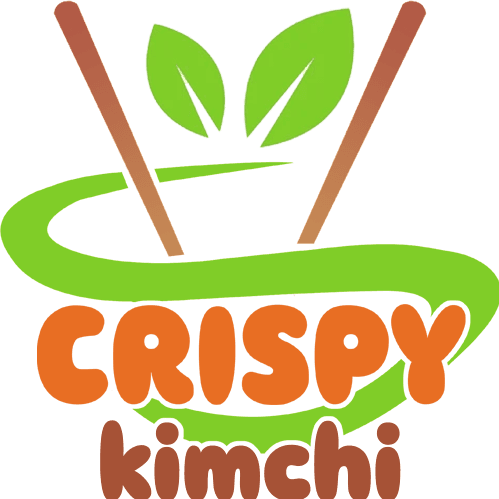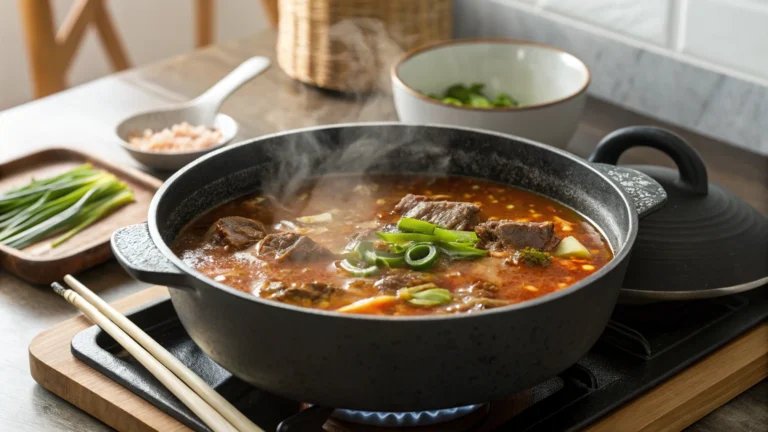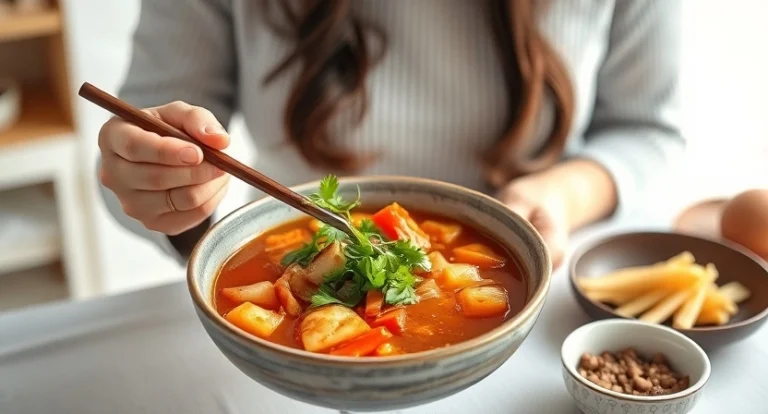Dotorimuk Muchim: Acorn Jelly Salad
A unique Korean dish featuring savory, nutty, and slightly sweet flavors with a bouncy, gelatinous texture that you must experience!
Introduction: Unveiling the Delight of Dotorimuk Muchim
Have you ever encountered a dish that’s as intriguing as it is delicious? A culinary experience that challenges your understanding of textures and flavors? Well, prepare to embark on a fascinating journey into the heart of Korean cuisine with Dotorimuk Muchim, a dish as unique as its ingredients. This isn’t your typical salad; it’s a celebration of earthy flavors, a testament to the resourceful spirit of Korean cooking, and an utterly unforgettable culinary experience. Therefore, if you’re looking for an adventure in the kitchen, this recipe is for you.
Dotorimuk Muchim, at its core, is a Korean acorn jelly salad. Yes, you heard right – acorn jelly. In addition, this is not just any jelly, but a creation with a history as deep as the Korean landscape itself. The dish is characterized by its surprisingly pleasant texture and the harmonious blend of savory, nutty, and subtly sweet flavors. It’s a testament to the beauty of simple ingredients transformed into something extraordinary. It represents a historical dish that showcases the ingenuity of Korean cuisine and its ability to create something incredible from humble beginnings.
Furthermore, the combination of the unique texture of the acorn jelly and the vibrant flavors of the dressing and vegetables make this dish truly special. Consequently, it’s a fantastic option for anyone looking to expand their culinary horizons, try something new, or simply explore the rich tapestry of Korean flavors. In this article, we will delve into the world of Dotorimuk Muchim, uncovering its essence and how you can easily recreate this traditional dish at home. For more insights into Korean cuisine, exploring sites like Korean Bapsang can be incredibly helpful.

Understanding the Star: Dotorimuk (Acorn Jelly)
First, let’s delve deeper into the primary ingredient: Dotorimuk, which is essentially acorn jelly. This isn’t your average gelatin; instead, it is a product derived from acorns, which makes it rather unique. The process of creating Dotorimuk is quite labor-intensive, reflecting a time when resourcefulness was key. Acorns are carefully processed to extract the starch, which then is used to create this jiggly delight. The acorns typically used come from oak trees, which are abundant in Korea. The collected acorns undergo extensive washing and soaking to remove tannins, which can cause bitterness, and then the starch is extracted. Therefore, the result is a light brown or tan-colored jelly with a wonderfully bouncy, almost playful texture.
Plain Dotorimuk boasts a subtle flavor profile. Specifically, it’s characterized by a mild, earthy, and slightly nutty taste that complements its unique texture. It’s neither too sweet nor too savory, which makes it a perfect blank canvas for the flavorful Muchim dressing. In addition, Dotorimuk is not just a delightful ingredient because of its texture and mild taste, but it also has health benefits. Acorn jelly is known to be low in calories and high in fiber, contributing to a healthy diet. Indeed, many consider it a great addition to a balanced meal. Therefore, its unique properties and benefits make it more than just a simple jelly.
The Acorn Connection: A Deeper Look
Moreover, the acorns used to make Dotorimuk are a testament to Korean resourcefulness. In times of scarcity, acorns were an essential food source. The process of making Dotorimuk, from collecting the acorns to preparing the final jelly, is a time-honored tradition that has been passed down through generations. Therefore, this isn’t just about a food item, it’s a celebration of Korea’s history. If you’re interested in more traditional Korean food preparations, resources like My Korean Kitchen offer great insights.
A Symphony of Flavors: The Essence of Muchim
Muchim, the term used in the name of the dish, isn’t just a word; it’s a style of Korean cooking. Specifically, Muchim refers to dishes that are seasoned and mixed, much like a salad. The magic of Dotorimuk Muchim lies in its dressing, which transforms the mild Dotorimuk into a flavor explosion. The dressing is a vibrant blend of sweet, savory, and spicy notes. Therefore, the careful combination of ingredients makes each bite a delightful experience.
Key Components of Muchim Flavor
The core flavor components of Muchim are what make it truly stand out. Gochugaru, Korean chili flakes, provides a unique, mild heat and vibrant color. Soy sauce adds the necessary umami, and sesame oil brings a nutty aroma and flavor. Also, freshly minced garlic gives the dish its distinctive pungency, while green onions offer a fresh, slightly sharp note. In addition, sugar is often added to balance the flavors, creating a harmonious blend of sweet, salty, and spicy. Therefore, these core ingredients create a balanced and layered flavor profile.
Furthermore, some variations of the Muchim sauce may also include vinegar or rice wine vinegar, which is added for that perfect tanginess. These additions bring a wonderful brightness to the dish, enhancing its complexity and making it even more enjoyable. Finally, the role of texture is vital. The crispness of fresh vegetables, like cucumbers and carrots, contrasts beautifully with the jiggly Dotorimuk, creating a pleasing sensory experience. Therefore, the perfect Muchim is a careful balancing act that highlights the best qualities of all ingredients.

The Essential Recipe: Making Dotorimuk Muchim at Home
Now, let’s get to the heart of the matter: how to prepare Dotorimuk Muchim at home. It’s easier than you might think, and the result is truly worth the effort. This recipe is designed for easy follow-along, ensuring that even beginners can master this unique Korean salad. In fact, this is a great recipe that will impress your family and friends with its unique flavors and textures. For additional guidance or variations, you can explore recipes by chefs like Maangchi.
Ingredients:
- 1 package (about 300g) Dotorimuk (Acorn Jelly), available at Korean markets or online
- 1/2 cup Cucumber, julienned
- 1/2 cup Carrot, julienned
- 2 Green Onions, thinly sliced
- For the Muchim Sauce:
- 2 tablespoons Gochugaru (Korean chili flakes)
- 2 tablespoons Soy Sauce
- 1 tablespoon Sesame Oil
- 1 tablespoon Minced Garlic
- 1 tablespoon Sugar or honey or agave (adjust to your preference)
- 1 teaspoon Rice wine vinegar (optional)
- 1 tablespoon Sesame Seeds, for garnish
- A pinch of chili flakes for extra heat (optional)
Step-by-Step Instructions:
- Prepare the Dotorimuk: Gently remove the Dotorimuk from its packaging. Cut or slice it into bite-sized pieces, usually 1-2 inch pieces. Be careful not to break it too much, as it can be delicate. It’s important to handle the Dotorimuk with care, ensuring the pieces maintain their unique texture.
- Prepare the Vegetables: Wash and julienne the cucumber and carrot. Thinly slice the green onions. The julienned vegetables are not just pretty; they also provide a nice crunch that complements the jelly.
- Make the Muchim Sauce: In a small bowl, combine the gochugaru, soy sauce, sesame oil, minced garlic, sugar, and rice wine vinegar (if using). Whisk all the ingredients together thoroughly until well mixed. The sauce is the key to the dish, so make sure it’s well combined.
- Combine and Mix: In a large bowl, gently combine the sliced Dotorimuk, the julienned vegetables, and the prepared Muchim sauce. Gently toss everything together until all the pieces are well coated with the sauce. Be careful to not mash the Dotorimuk while mixing.
- Garnish: Transfer the Dotorimuk Muchim to a serving plate. Sprinkle with sesame seeds and an extra pinch of chili flakes if desired. This adds a final touch of flavor and visual appeal.

Tips for Success:
- When slicing the Dotorimuk, use a gentle hand to avoid breaking it into smaller pieces.
- Adjust the spice level of the Muchim sauce to suit your taste.
- Mix the salad just before serving to keep the vegetables crispy and the sauce at its best.
- For a more intense flavor, prepare the sauce a few hours ahead to let the flavors meld.
- If using, add the rice wine vinegar at the very end.
Variations & Adaptations:
- Vegan Options: Substitute the honey with maple syrup or agave.
- Vegetable Additions: Add other fresh vegetables, such as bell peppers, sprouts, or perilla leaves, to enhance the texture and flavor.
- Protein Additions: To make it a complete meal you can add protein sources, such as mushrooms or tofu.
Nutritional Information (per 100g approximate):
| Nutrient | Amount |
| Calories | 60 |
| Total Fat | 3g |
| Saturated Fat | 0.5g |
| Cholesterol | 0mg |
| Sodium | 200mg |
| Total Carbohydrate | 8g |
| Dietary Fiber | 2g |
| Total Sugars | 2g |
| Protein | 1g |
Note: Nutritional values can vary based on specific ingredients and preparation methods.
Serving and Enjoying Dotorimuk Muchim
Dotorimuk Muchim is a versatile dish that can be enjoyed in various ways. In Korean cuisine, it is usually served as a side dish, known as Banchan. It’s a fantastic addition to any meal, adding a unique textural and flavorful element. It can be served as an appetizer or as a refreshing side to a main course. Furthermore, it is typically served chilled or at room temperature, perfect for warm days.
This dish pairs beautifully with a variety of Korean dishes, such as Bibimbap, Bulgogi, and Korean BBQ. Its vibrant flavor complements the richness of other dishes, adding a refreshing element to the meal. Consequently, Dotorimuk Muchim is a great option to include when you are planning a Korean feast for family and friends. Also, garnishes can add that perfect final touch. For example, a sprinkle of dried seaweed flakes, a few drops of toasted sesame oil, or a touch of chili flakes can enhance both its taste and presentation. These add a little something extra that makes all the difference.
If you have leftovers, store them in an airtight container in the refrigerator for up to 2 days. However, it’s best to eat the Dotorimuk Muchim fresh to enjoy its texture and vibrant flavors at their peak. Therefore, make just the amount needed so it is fresh, and you can enjoy it as soon as possible.

The Cultural Journey: Dotorimuk Muchim in Korean History & Culture
Dotorimuk Muchim is more than just a dish; it’s a piece of Korean history. Historically, acorns were a readily available source of food, particularly during times of scarcity. Koreans developed techniques to process acorns and transform them into the gelatinous delight we know as Dotorimuk. Therefore, this dish has evolved from an essential staple to a beloved part of Korean cuisine.
The preparation of Dotorimuk Muchim, while varying slightly by region, reflects the creativity and adaptability of Korean cooking. While there aren’t vast regional variations, each household often has its own special way of preparing the dish. Today, Dotorimuk Muchim is still cherished in Korea, enjoyed as a traditional and wholesome dish. The use of natural ingredients and the careful preparation speaks to the deep-rooted culinary traditions of the nation. It’s a reminder of the simple, yet profound, relationship between food and culture.
Furthermore, trying Dotorimuk Muchim is a great way to connect with Korean heritage. It allows you to taste a little bit of history and experience the flavors that have been enjoyed in Korean households for generations. Therefore, it provides an excellent insight into the Korean way of life and its culinary heritage.
Troubleshooting and FAQs
Let’s address some common questions and issues you might encounter when preparing Dotorimuk Muchim. This way, you can be well-prepared and make this dish with confidence. Having all the information you need will make it easy to prepare and to enjoy the experience.
Common Questions About Dotorimuk
Where can I find Dotorimuk? Dotorimuk can usually be found at Korean markets, online retailers specializing in Asian ingredients, or in the international sections of some larger supermarkets.
How do I store Dotorimuk? Fresh Dotorimuk should be stored in its packaging in the refrigerator until ready to use. Once opened, use it within a few days, keeping it submerged in water if necessary to prevent drying.
Addressing Common Mistakes
- Over-saucing: Start with a smaller amount of sauce and add more gradually to avoid overpowering the delicate flavor of Dotorimuk.
- Under-seasoning: Taste as you go and add more sauce if needed to achieve the perfect balance of flavors.
- Rushing the mixing: Be gentle when mixing to avoid breaking the Dotorimuk.
FAQs
What does Dotorimuk taste like? Dotorimuk has a very mild flavor, slightly nutty and earthy. However, it really acts as a blank canvas for the more flavorful Muchim sauce. Therefore, it primarily absorbs the flavors of the dressing.
Why do Koreans eat acorn jelly? Historically, acorns were a readily available food source, especially during times of scarcity. Nowadays, it is enjoyed as a traditional dish because of its unique texture and health benefits.
Is Korean acorn jelly healthy? Yes, Dotorimuk is considered a healthy food as it’s low in calories and high in fiber, which can aid in digestion.
How to eat acorn muk? Acorn muk, or Dotorimuk, is typically eaten as part of a dish, like Dotorimuk Muchim, with seasonings, sauces, and vegetables that bring it to life.
Conclusion: A Taste of Korea
Dotorimuk Muchim is a culinary adventure, a journey into the heart of Korean flavors and traditions. It is a unique and delicious dish that combines a fascinating history with a refreshing taste and wonderful textures. Its combination of earthy, nutty, and savory notes, along with its unique texture, makes it a truly special culinary experience.
Now that you’ve learned all about Dotorimuk Muchim, we encourage you to try it at home. Don’t be afraid to experiment with the recipe and customize it to your liking. We are sure that once you taste it, you’ll be hooked.
Finally, we hope that this article has inspired you to expand your culinary horizons. We invite you to explore more Korean recipes on our website and continue this incredible culinary adventure!
External Links:







